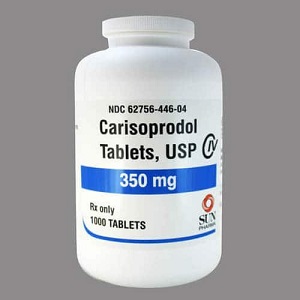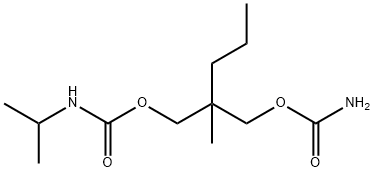ChemicalBook > CAS DataBase List > Carisoprodol
Carisoprodol
Carisoprodol
- CAS No.78-44-4
- Chemical Name:Carisoprodol
- CBNumber:CB0215440
- Molecular Formula:C12H24N2O4
- Formula Weight:260.33
- MOL File:78-44-4.mol
Carisoprodol Property
- Melting point 92-92°C
- Boiling point 403.59°C (rough estimate)
- Density 1.1035 (rough estimate)
- refractive index 1.4560 (estimate)
- storage temp. 2-8°C
- solubility Very slightly soluble in water, freely soluble in acetone, in alcohol and in methylene chloride.
- form Solid
- pka pKa 4.2 (Uncertain)
- color White to Off-White
- biological source rabbit
- Water Solubility <0.1 g/100 mL at 19.5 ºC
- BCS Class 2/4
- InChI InChI=1S/C12H24N2O4/c1-5-6-12(4,7-17-10(13)15)8-18-11(16)14-9(2)3/h9H,5-8H2,1-4H3,(H2,13,15)(H,14,16)
- InChIKey OFZCIYFFPZCNJE-UHFFFAOYSA-N
- SMILES C(OCC(COC(N)=O)(C)CCC)(=O)NC(C)C
- CAS DataBase Reference 78-44-4(CAS DataBase Reference)
- EWG's Food Scores 1
- FDA UNII 21925K482H
- ATC code M03BA02
- NIST Chemistry Reference Carisoprodol(78-44-4)
- EPA Substance Registry System Carisoprodol (78-44-4)
- UNSPSC Code 41116107
- NACRES NA.41
Safety
- Hazard Codes :Xn
- Risk Statements :22
- Safety Statements :36
- RTECS :FB3325000
- HS Code :29224999
- Hazardous Substances Data :78-44-4(Hazardous Substances Data)
- Toxicity :LD50 in mice, rats (mg/kg): 2340, 1320 orally; 980, 450 i.p. (Berger)
-
NFPA 704:
0 1 0
-
Symbol(GHS)

- Signal wordWarning
- Hazard statements H302
- Precautionary statements P264-P270-P301+P312-P501
Carisoprodol Price
More Price(2)
- Brand: TCI Chemicals (India)
- Product number: C3573
- Product name : Carisoprodol
- Purity:
- Packaging: 5G
- Price: ₹5200
- Updated: 2022/05/26
- Buy: Buy
- Brand: TCI Chemicals (India)
- Product number: C3573
- Product name : Carisoprodol
- Purity:
- Packaging: 25G
- Price: ₹9200
- Updated: 2022/05/26
- Buy: Buy
Carisoprodol Chemical Properties,Usage,Production
- Description Carisoprodol (CRM) (Item No. ISO60206) is a certified reference material categorized as a skeletal muscle relaxant. It also has sedative properties. Carisoprodol is regulated as a Schedule IV compound in the United States. Carisoprodol (CRM) (Item No. ISO60206) is provided as a DEA exempt preparation. This product is intended for research and forensic applications.
- Description Carisoprodol (Item No. 30778) is an analytical reference standard categorized as a skeletal muscle relaxant. It also has sedative properties. Carisoprodol is regulated as a Schedule IV compound in the United States. This product is intended for research and forensic applications.
- Chemical Properties White Solid
- Originator Soma,Wallace,US,1959
- Uses For the relief of discomfort associated with acute, painful, musculoskeletal conditions.
- Uses Carisoprodol suppresses interneuronal action of reticular formation of the spinal cord. It is used as an adjuvant drug for loss of flexibility of skeletal muscle as well as for relieving pain caused therein. Synonyms of this drug are rela, soma, carisoma, and sanoma.
-
Uses
Muscle relaxant (skeletal)
Carisoprodol has an onset of action of ca. 30min and a duration of 4–6h. It is administered orally. Presumably, it acts by inhibiting interneuronal activity in the spinal cord and the brainstem reticular formation. Clinically effective doses are accompanied by drowsiness or dizziness; its mechanism may involve sedation.Its CNS depressant effects are additive with those of ethanol and other psychotropic agents. Carisoprodol has a low potential for drug dependence.

- Definition ChEBI: A carbamate ester that is the mono-N-isopropyl derivative of meprobamate (which is a significant metabolite). Carisoprodol interrupts neuronal communication within the reticular formation and spinal cord, resulting in sedation and alter tion in pain perception. It is used as a muscle relaxant in the symptomatic treatment of musculoskeletal conditions associated with painful muscle spasm.
- Preparation Carisoprodol is Prepared by reaction of 2-methyl-2-propyl-1,3-pro-panediol with phosgene and ammonium hydroxide, then with isopropyl isocyanate.
-
Manufacturing Process
A cooled 10% solution of 1 mol of phosgene in toluene was added with
stirring to a cooled solution of 1 mol of 2-methyl-2-propyl-1,3-propanediol and
2 mols of dimethylaniline also dissolved in toluene, at such a rate that the
temperature of the mixture was maintained at about 25°C. The mixture was
allowed to remain at this temperature for several hours, then cooled and
extracted with cold 5% hydrochloric acid solution to remove the
dimethylaniline. The toluene layer was dried using a suitable drying agent and
the 2-methyl-2-propyl-3-hydroxypropyl chlorocarbonate used in subsequent
reactions in the form of its solution in anhydrous toluene.
A quantity of solution obtained as described containing 0.1 mol of the chlorocarbonate was treated with 0.2 mol of anhydrous isopropylamine and allowed to react at ordinary room temperature. The solution was cooled, extracted with dilute hydrochloric acid and the organic layer concentrated by evaporation of the solvent. The crude monocarbamate was purified by distilling at 86° to 88°C at about 0.01 mm. It was a clear, viscous liquid.
21.7 g (0.1 mol) of N-isopropyl-2-methyl-2-propyl-3-hydroxypropylcarbamate and 7.5 g (0.11 mol) of anhydrous sodium cyanate are stirred in 200 ml anhydrous chloroform in a suitable vessel equipped with a gas inlet tube,stirrer and thermometer. While cooling the vessel, anhydrous hydrogen chloride is passed into the stirred mixture slowly for 5 hours maintaining the temperature between 0° and 5°C. Alternatively ethyl urethane in the presence of aluminum isopropylate as a catalyst may be used in place of the sodium cyanates and HCl. The mixture is then allowed to stand at room temperature overnight.
The solid material is separated by filtration and the chloroform solution concentrated to an oil under reduced pressure. The oil is dissolved in 50 ml of trichloroethylene, the solution treated with charcoal, filtered and the filtrate added to 125 ml of hexane. The crystalline material which forms on standing at refrigerator temperature is removed by filtration, washed with light petroleum ether and dried at about 50°C. Approximately 20 g of product are obtained. On recrystallizing from trichloroethylene-hexane, 17.8 g of purified compound are obtained, MP 89° to 91°C. - brand name Rela (Schering); Soma (Medpointe).
- Therapeutic Function Muscle relaxant
- General Description Carisoprodol, N-isopropyl-2-methyl-2-propyl-1,3-propanediol dicarbamate, 2-methyl-2-propyl-1,3-propanediol carbamate isopropylcarbamate(Soma), is the mono-N-isopropyl–substituted relative ofmeprobamate. The structure is given in the discussion ofmeprobamate. It is indicated in acute skeletomuscular conditionscharacterized by pain, stiffness, and spasm. As canbe expected, a major side effect of the drug is drowsiness.
- Air & Water Reactions Insoluble in water.
- Reactivity Profile Carisoprodol is a carbamate ester. Carbamates are chemically similar to, but more reactive than amides. Like amides they form polymers such as polyurethane resins. Carbamates are incompatible with strong acids and bases, and especially incompatible with strong reducing agents such as hydrides. Flammable gaseous hydrogen is produced by the combination of active metals or nitrides with carbamates. Strongly oxidizing acids, peroxides, and hydroperoxides are incompatible with carbamates.
- Health Hazard SYMPTOMS: The most common symptoms of exposure to Carisoprodol are drowsiness and hives. Other symptoms may include nausea, vomiting, epigastric distress, vertigo, ataxia, tremors, agitation, irritability, headache, insomnia, fainting, hiccups, visual disturbances, asthma, fever, hypotension, excitement and paralysis.
- Fire Hazard Flash point data for Carisoprodol are not available, but Carisoprodol it probably combustible.
-
Synthesis
Carisoprodol, N-iso-propyl-2-methyl-2-propyl-1,3-propanediol (15.3.12),
is synthesized by reacting 2-methyl-2-propylpropanediol-1,3 dicarbamate with 1 mol of
phosgene, forming the chloroformate (15.3.10), from which carbamate (15.3.11) is formed
by reacting it with isopropylamine. Reacting this with either urethane or sodium cyanate
gives carisoprodol (15.3.12).

Carisoprodol Preparation Products And Raw materials
Raw materials
Preparation Products
Global(323)Suppliers
-
Supplier:
Hebei Lingding Biotechnology Co., Ltd.
- Tel:+86-18134017493<br/>+86-18134017493
- Email:sunflowerfranklin20@gmail.com
- Country:China
- ProdList:108
- Advantage:58
-
Supplier:
Hebei Yanxi Chemical Co., Ltd.
- Tel: +8617531153977
- Email:allison@yan-xi.com
- Country:China
- ProdList:5854
- Advantage:58
-
Supplier:
RongNa Biotechnology Co.,Ltd
- Tel:+86-86-13583358881<br/>+8618560316533
- Email:Brad@rongnabiotech.com
- Country:China
- ProdList:3084
- Advantage:58
-
Supplier:
Hebei Chuanghai Biotechnology Co,.LTD
- Tel: +86-13131129325
- Email:sales1@chuanghaibio.com
- Country:China
- ProdList:5868
- Advantage:58
-
Supplier:
Henan Bao Enluo International TradeCo.,LTD
- Tel:+86-17331933971<br/>+86-17331933971
- Email:deasea125996@gmail.com
- Country:China
- ProdList:2472
- Advantage:58
-
Supplier:
Hebei Kangcang new material Technology Co., LTD
- Tel: +8615713292910
- Email:Nancy@kangcang.com.cn
- Country:China
- ProdList:341
- Advantage:58
-
Supplier:
hebei hongtan Biotechnology Co., Ltd
- Tel:+852-6619 3215<br/>+86-17731935328
- Email:sales03@chemcn.cn
- Country:China
- ProdList:970
- Advantage:58
-
Supplier:
Shaanxi TNJONE Pharmaceutical Co., Ltd
- Tel:+86-17396673057
- Email:linda@tnjone.com
- Country:China
- ProdList:1143
- Advantage:58
-
Supplier:
Capot Chemical Co.,Ltd.
- Tel:+86-(0)57185586718<br/>+86-13336195806
- Email:sales@capot.com
- Country:China
- ProdList:29730
- Advantage:60
-
Supplier:
Shanxi Naipu Import and Export Co.,Ltd
- Tel:+86-13734021967<br/>+8613734021967
- Email:kaia@neputrading.com
- Country:China
- ProdList:1001
- Advantage:58
78-44-4, CarisoprodolRelated Search:
- 78-44-4
- ACTIVE PHARMACEUTICAL INGREDIENTS
- API intermediates
- Pharmacologicals
- Neurobiology
- Muscle Relaxants
- Pharmaceuticals
- Intermediates & Fine Chemicals
- Isotope Labeled Compounds
- Amines
- Aliphatics
- SOMA
- API
- 试剂
- 其他
- 化工原料
- 标准品
- 医药体
- 医药原料
- 化工中间体工业原料
- 其他原料药
- 原料
- 原料药
- 医药原料
- 小分子抑制剂
- 神经系统用药
- 其他科研原料药
- C12H18D6N2O4
- 40%乙腈水中卡利普多溶液标准物质
- 卡立普多(对照品)
- CARISOPRODOL(控制药物)
- CARISOPRODOL[干冰运输]
- 卡立普多 EP标准品
- 卡利普多(异丙基甲丁双脲)
- 卡立普多
- 异丙基甲丁双脲-D3
- 异丙基甲丁双脲
- 卡立普多生产
- 异丙基甲丁双脲杂质
- 卡立普多(标准品)
- 异庚二酯
- 异丙基眠尔通
- 异丙安宁
- 异氨甲丙二酯
- 卡来梯
- 肌安宁
- 卡利普多
- 78-44-4
- Resistin-like Protein α EIA Kit
- *Argatroban Impurity 99(Methacrolein)
- Carisoprodol in methanol
- CARISOPRODO
- Carbamic acid, (1-methylethyl)-, 2-[[(aminocarbonyl)oxy]methyl]-2-methylpentyl ester
- RELA
- Carisoprodol (BP/EP)
- Carisoprodol (CRM)
- Carisoprodol CRS
- Isopropylcarbamic Acid 2-[(Carbamoyloxy)methyl]-2-methylpentyl Ester
